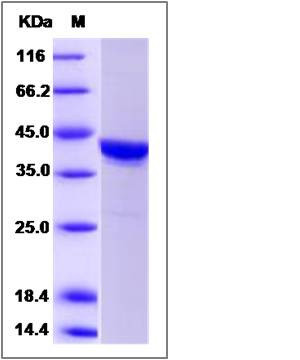Mouse CSNK2A1 / CK2A1 Protein
Csnk2a1-rs4
- 100ug (NPP3280) Please inquiry
| Catalog Number | P50818-MNCB |
|---|---|
| Organism Species | Mouse |
| Host | Baculovirus-Insect Cells |
| Synonyms | Csnk2a1-rs4 |
| Molecular Weight | The recombinant mouse CSNK2A1 consists of 393 amino acids and predicts a molecular mass of 45.3 KDa. It migrates as an approximately 40 KDa band in SDS-PAGE under reducing conditions. |
| predicted N | Gly |
| SDS-PAGE |  |
| Purity | > 95 % as determined by SDS-PAGE |
| Protein Construction | A DNA sequence encoding the mouse CAMK4 CSNK2A1 (Q60737) (Met1-Gln391) was expressed and purified with two additional amino acids (Gly & Pro) at the N-terminus. |
| Bio-activity | Kinase activity untested |
| Research Area | Signaling |Signal Transduction |Akt Pathway |Intracellular Kinases in the Akt Pathway |
| Formulation | Lyophilized from sterile 20mM Tris, 500mM NaCl, 10% glycerol, pH 7.4. 1. Normally 5 % - 8 % trehalose, mannitol and 0.01% Tween80 are added as protectants before lyophilization. Specific concentrations are included in the hardcopy of COA. |
| Background | Casein kinase II subunit alpha, also known as CK II alpha, CSNK2A1 and CK2A1, is a member of the protein kinase superfamily, Ser / Thr protein kinase family and CK2 subfamily. Casein kinase II (CSNK2A1) is a serine / threonine protein kinase that phosphorylates acidic proteins such as casein. This kinase is composed of an alpha, an alpha-prime, and two beta subunits. The alpha subunits contain the catalytic activity while the beta subunits undergo autophosphorylation. Casein kinase II (CSNK2A1) is a constitutively active, ubiquitously expressed serine / threonine protein kinase that is thought to have a regulatory function in cell proliferation, cell differentiation and apoptosis. CSNK2A1 functions as a tetrameric complex consisting of two regulatory beta-subunits and two catalytic units (alpha and alpha') in a homomeric or heteromeric conformation. Whilst the alpha- and alpha'-subunits are catalytically identical, proteins that regulate CSNK2A1, such as cdc2 and Hsp90, preferentially bind to the alpha and not the alpha'-subunit. CSNK2A1 can phosphorylate a number of key intracellular signaling proteins implicated in tumor suppression (p53 and PTEN) and tumorigenesis (myc, jun, NF-kappaB). CSNK2A1 is also thought to influence Wnt signaling via beta-catenin phosphorylation and the PI 3-K signaling pathway via th phosphorylation of Akt. |
| Reference |
